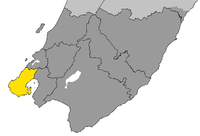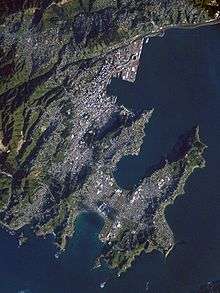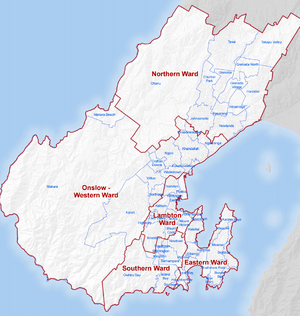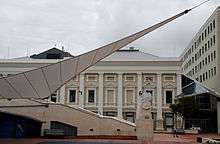Wellington City Council
Wellington | |
 | |
 Wellington City (yellow) in the Wellington Region | |
| Country | |
| Population: | 207,900 (June 2016)[1] |
| Land area: | 290.11 km² (112.01 sq mi) |
| Extent: | Extends north as far as Ohariu, Linden, Takapu Valley and Horokiwi. Bounded on the south and west by Cook Strait and the east by Wellington Harbour. |
| Mayor: | Justin Lester (since 2016) |
| Regional Council: | Wellington Regional Council |

Wellington City Council is a territorial authority in New Zealand, representing the country's third-largest city by population, behind Auckland and Christchurch. Wellington City consists of the central historic town and certain additional areas within the Wellington metropolitan area, extending as far north as Linden and covering rural areas such as Makara and Ohariu. The city adjoins Porirua in the north and Hutt City in the north-east.
Wellington attained city status in 1886. The settlement had become the colonial capital and seat of government by 1865, replacing Auckland. Parliament officially sat in Wellington for the first time on 26 July 1865. During the last half of the nineteenth century Wellington grew rapidly from 7,460 residents in 1867 to 49,344 by the end of the century.[2]
The council represents a population of 207,900 (as of 2016),[1] and consists of a mayor and fourteen councillors elected from five wards (Northern, Onslow-Western, Lambton, Eastern, Southern).[n 1][3] It administers public works, sanitation, land use and building consents, among other local services. The council has used the marketing slogan "Absolutely Positively Wellington" in an official capacity since the early 1990s.[4]
The territorial authority is one of many councils in the greater Wellington area. Former mayor Celia Wade-Brown spoke against Wellington adopting a 'super city' type council like the one in Auckland, though is in favour of reducing the number of councils in the Wellington metropolitan area from nine to "three or four".[5]
Council
All councillors are members of Council, the City Strategy Committee, and the Long-Term and Annual Plan Committee.[6]
Mayor
One mayor is elected at large from the entire Wellington City district.
| Name | Affiliation (if any) | First elected | Responsibilities | |
|---|---|---|---|---|
| Justin Lester[7] | Labour | 2016 |
|
Eastern Ward
The Eastern ward returns three councillors to the Wellington City Council.
| Name | Affiliation (if any) | First elected | Responsibilities | |
|---|---|---|---|---|
| Sarah Free | Greens | 2013 |
| |
| Simon "Swampy" Marsh | Independent | 2010 |
| |
| Chris Calvi-Freeman | Independent | 2016 |
|
Lambton Ward
The Lambton ward returns three councillors to the Wellington City Council.
| Name | Affiliation (if any) | First elected | Responsibilities | |
|---|---|---|---|---|
| Iona Pannett | Greens | 2007 |
| |
| Nicola Young | Independent | 2013 |
| |
| Brian Dawson[8] | Labour | 2016 |
|
Northern Ward
The Northern ward returns three councillors to the Wellington City Council.
| Name | Affiliation (if any) | First elected | Responsibilities | |
|---|---|---|---|---|
| Malcolm Sparrow | Independent | 2013 |
| |
| Jill Day[9] | Independent | 2016 |
| |
| Peter Gilberd | Labour | 2016 |
|
Onslow-Western Ward
The Onslow-Western ward returns three councillors to the Wellington City Council.
| Name | Affiliation (if any) | First elected | Responsibilities | |
|---|---|---|---|---|
| Andy Foster | Independent | 1992 |
| |
| Simon Woolf | Independent | 2013 |
| |
| Diane Calvert | Independent | 2016 |
|
Southern Ward
The Southern ward is the only ward that returns two councillors to the Wellington City Council (all others returning three).
| Name | Affiliation (if any) | First elected | Responsibilities | |
|---|---|---|---|---|
| Paul Eagle | Labour | 2010 |
| |
| David Lee | Greens | 2013 |
|
Coat of arms

The City of Wellington has a Coat of Arms. The Blazon is;
- Arms: Quarterly Gules and Azure, a Cross Or between; In the first quarter a Fleece Or; in the second quarter on Water barry wavy proper in base a Lymphad sail furled pennon and flags flying Argent; in the third quarter a Garb Or; in the fourth quarter five Plates in Saltire Argent.
- Crest: On a Mural Crown Argent a Dolphin Naiant Azure, Mantled Gules.
- Supporters: On the dexter side a Lion gorged with a Collar and Chain reflexed over the back Or, and on the sinister side a Moa proper.
- Motto: Suprema a Situ
Translation of the Blazon:
The shield is divided vertically and horizontally quarter of which the first and fourth are red and the remaining pair are blue. A golden cross is placed over the entire shield centrally between these quarters. The top left quarter contains a golden fleece (usually depicted as a whole sheep with a band around its middle). The second quarter is depicted as a silver sailing ship (lymphad) with its sails furled as it would be in port but with its flags flying, placed on waves in their natural colour. The third quarter contains a golden wheat sheaf, and the fourth has five silver discs arranged in a saltire.
The mural crown (a crown depicted as if made of stone walling) is common as a crest in city coats of arms. It is coloured silve, and from its top comes a swimming dolphin. Around the crest is mantling in red. The supporters on either side of the shield are a golden heraldic lion with a chained collar around its neck to the left, and a moa in its natural colouring on the right (the terms "sinister" and "dexter" relate to the shield from the holder's point of view, not the viewer's, thus dexter is the viewer's left and sinister is the viewer's right). The base on which the supporters stand is normally not emblazoned but is left to the artist to decide. The Motto may be translated as "Supreme by position".
Demographics
Wellington's demographics sets it apart from the rest of the country. According to the 2006 Census, Wellington has:
- The second-largest percentage of people in their twenties and thirties (37.3% compared to 27.4% nationally).
- The least number of people in their sixties (6.4%) and the second least number of people aged over sixty (12.2%).
Suburbs
Wellington city has roughly 60 officially-defined suburbs; one can group them by the wards used to elect the City Council. Some areas, while officially forming part of a larger suburb (or several suburbs), are considered by some to be separate communities. The officially-defined suburbs include:

Northern Ward
- official: Broadmeadows; Churton Park; Glenside; Grenada; Grenada North; Horokiwi; Johnsonville; Newlands; Ohariu; Paparangi; Tawa; Takapu Valley; Woodridge
- informal: Greenacres; Redwood; Linden
Onslow-Western Ward
- official: Karori; Northland; Crofton Downs; Kaiwharawhara; Khandallah; Ngaio; Ngauranga; Makara; Makara Beach; Wadestown; Wilton.
- informal: Cashmere; Chartwell; Highland Park; Rangoon Heights; Te Kainga
Lambton Ward
- official: Brooklyn; Aro Valley; Kelburn; Mount Victoria; Oriental Bay; Te Aro; Thorndon; Highbury; Pipitea
Southern Ward
- official: Berhampore; Island Bay; Newtown; Vogeltown; Houghton Bay; Kingston; Mornington; Mount Cook; Owhiro Bay; Southgate
- informal: Kowhai Park
Eastern Ward
- official: Hataitai; Lyall Bay; Kilbirnie; Miramar; Seatoun; Breaker Bay; Karaka Bays; Maupuia; Melrose; Moa Point; Rongotai; Roseneath; Strathmore
- informal: Crawford; Seatoun Bays; Seatoun Heights; Miramar Heights; Strathmore Heights.
Communities of common interest
- Courtenay Place; Courtenay Quarter; Cuba Quarter; Lambton Quarter; The Waterfront Quarter
Positively Wellington Tourism, funded by the Wellington City Council, has designated the four inner-city "quarters" as marketing subdivisions to promote international and domestic tourism.
Educational facilities

Victoria University of Wellington, Wellington's oldest university, has its main campus in the hill suburb of Kelburn overlooking the centre of the city. It also has two downtown campuses and one in the western suburb of Karori. It originated as a constituent college of the University of New Zealand. The senate of the University of New Zealand operated in Wellington until its dissolution in 1961.
A branch of Massey University is located in Wellington: it took over the site and some of the courses of the former Wellington Polytechnic. The campus is based at the former Dominion Museum, which has moved to Te Papa. The University of Otago also has a Wellington connection, as the Wellington School of Medicine and Health Sciences is a department of that university.
Wellington Institute of Technology serves Wellington and the neighbouring Hutt Valley. One of the largest polytechnics in the region, it dates from 1904.
Numerous primary and secondary educational institutions operate throughout the city, see List of schools in Wellington, New Zealand.
Wellington has a number of museums and galleries, including Te Papa, the City Gallery and the Museum of Wellington City & Sea. The Wellington Museums Trust runs the latter two, and other museums.
Sister-city relationships
- Sister cities[12]
-
 Sydney, Australia
Sydney, Australia -
 Canberra, Australia[13]
Canberra, Australia[13] -
 Beijing, People's Republic of China
Beijing, People's Republic of China -
 Xiamen, Fujian, People's Republic of China
Xiamen, Fujian, People's Republic of China -
 Sakai, Osaka, Japan
Sakai, Osaka, Japan
- Historical sister cities[14]
- Friendly cities[15]
-
 Tianjin, People's Republic of China
Tianjin, People's Republic of China
History
The City of Wellington has subsumed independent boroughs including:
- Melrose (established 1888) in 1903
- Onslow (Khandallah/Ngaio) (established 1890) in 1919 (Wadestown had joined the city in 1906)
- Karori (established 1891) in 1920
- Miramar (established 1904) in 1921
- Johnsonville (a Town Board from 1908), in 1953
- Tawa (a Town district from 1951, then the Tawa Flat Borough Council from 1953) in 1989
Buildings

The Wellington City Council operates from a complex on Wakefield Street, with various extensions each representing a distinctive architectural period. The complex incorporates the Wellington Town Hall which opened in 1904, with the most recent extension completed in 1991 alongside the Wellington Central Library.
See also
References
- Footnotes
- ↑ Multiple councillors are elected to a ward using the single transferable vote (STV) system
- Citations
- 1 2 "Subnational Population Estimates: At 30 June 2016 (provisional)". Statistics New Zealand. 21 October 2016. Retrieved 21 October 2016. For urban areas, "Subnational population estimates (UA, AU), by age and sex, at 30 June 1996, 2001, 2006-16 (2017 boundary)". Statistics New Zealand. 21 October 2016. Retrieved 21 October 2016.
- ↑ "Wellington region. Page 8 – From town to city: 1865–1899". TeAra.govt.nz. Te Ara Encyclopedia of New Zealand. Retrieved 15 November 2016.
- ↑ "Overview – Elections 2010 – Wellington City Council". Retrieved 10 August 2010.
- ↑ Maclean, Chris (14 November 2012). "Branding Wellington". TeAra.govt.nz. Te Ara Encyclopedia of New Zealand. Retrieved 14 October 2013.
- ↑ "No 'super city' for Wellington – mayor". 3 News NZ. 28 January 2013.
- ↑ "Sharp focus for Capital's new council". Retrieved 8 November 2016.
- ↑ "Justin Lester elected Mayor of Wellington". Retrieved 8 November 2016.
- ↑ "Reverend Brian Dawson moves from St Peters Church vicar to Wellington City Council". The Dominion Post. 3 November 2016.
- ↑ "Wellington City Council welcomes first female Maori councillor". Retrieved 8 November 2016.
- 1 2 "New city ambassador and scientist roles created for Wellington city councillors". The Dominion Post. 20 October 2016.
- ↑ "Wellington set to have first Maori deputy mayor". Retrieved 8 November 2016.
- ↑ "Sister Cities – Overview". Wellington City Council. Retrieved 19 November 2014.
- ↑ "Canberra and Wellington Strengthen Ties". ACT Government. Retrieved 6 July 2016.
- ↑ "Historical Sister Cities". Wellington City Council. Retrieved 18 January 2014.
- ↑ "Friendly cities". Wellington City Council. Retrieved 18 January 2014.
- A Complete Guide To Heraldry by A.C. Fox-Davies 1909.
External links
| Wikivoyage has a travel guide for Wellington. |
Coordinates: 41°17′44″S 174°46′50″E / 41.29556°S 174.78056°E